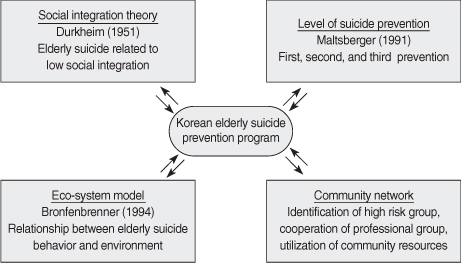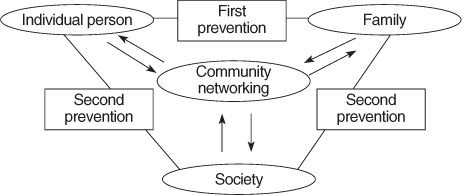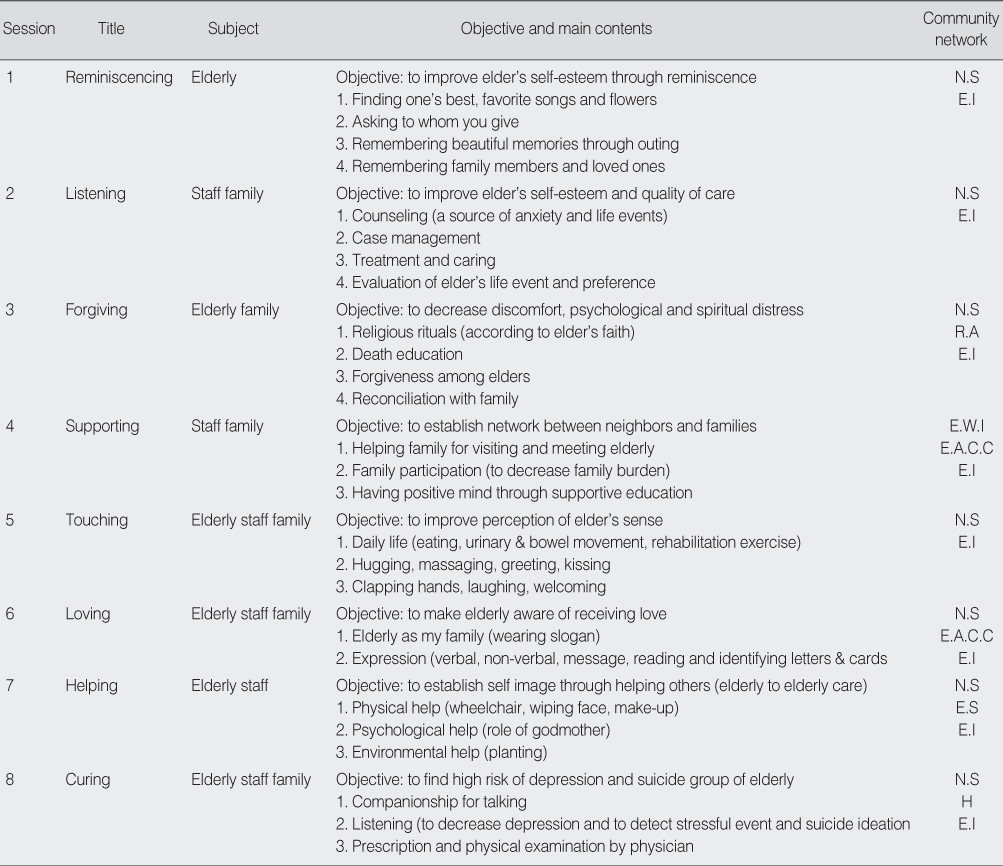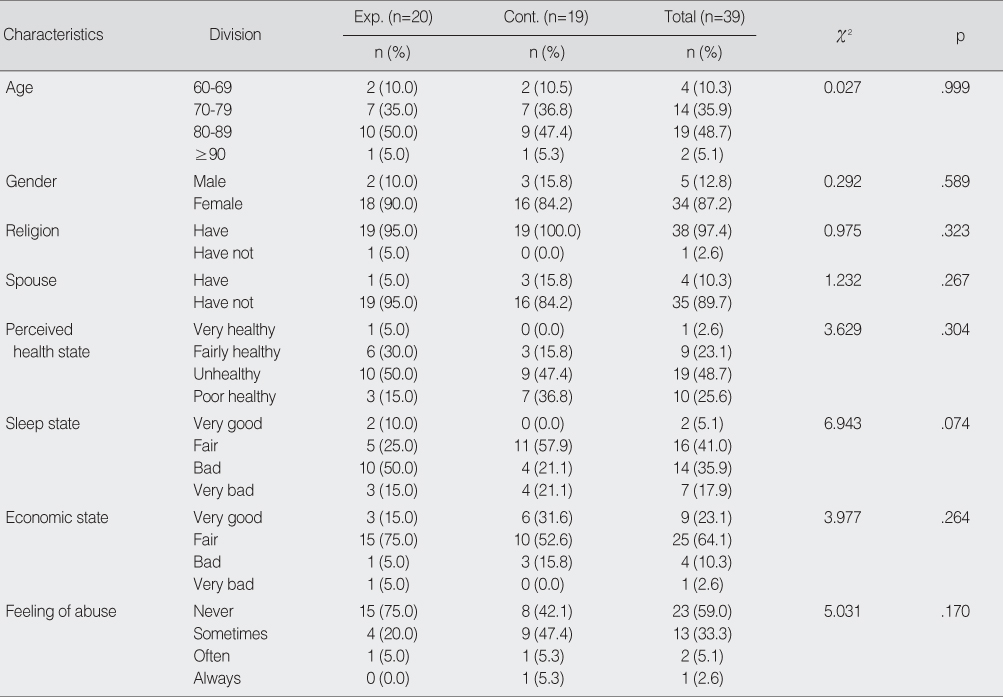Articles
- Page Path
- HOME > J Korean Acad Nurs > Volume 38(3); 2008 > Article
-
Original Article
- Development and Application of a Multidimensional Suicide Prevention Program for Korean Elders by utilizing a Community Network
- Kae-Hwa Jo, Yeong-Kyeong Kim
-
Journal of Korean Academy of Nursing 2008;38(3):372-382.
DOI: https://doi.org/10.4040/jkan.2008.38.3.372
Published online: June 30, 2008
1Associate Professor, Department of Nursing, Catholic University of Daegu, Daegu, Korea.
2Professor, School of Nursing, Catholic University of Pusan, Busan, Korea.
- Address reprint requests to: Jo, Kae Hwa. Department of Nursing, School of Medicine, Catholic University of Daegu, 3056-6 Daemyeong 4-dong, Namgu, Daegu 705-718, Korea. Tel: 82-53-650-4825, Fax: 82-53-621-4106, jokw@cu.ac.kr
Copyright © 2008 Korean Society of Nursing Science
Abstract
-
Purpose
- The purpose of this study was to develop a multidimensional suicide prevention program for Korean elders by utilizing a community network and to evaluate its effect.
-
Methods
- A non-equivalent control group pretest-posttest design was used. The subjects were recruited from two different elderly institutions located in D city and K province, Korea. Nineteen subjects in the control group received no intervention and 20 subjects in the experimental group received a multidimensional suicide prevention program.
-
Results
- There were more significant decreases in depression, suicide ideation, and increases in life satisfaction in the experimental group compared to the control group.
-
Conclusion
- According to the above results, the multidimensional suicide prevention program for Korean elders decreased stressful events like depression, and suicide ideation and increased life satisfaction through the community network. These findings suggest that this program can be used as an efficient intervention for elders in a critical situation.
This work was supported by the Korea Research Foundation Grant funded by the Korean Government (MOEHRD) (KRF-2007-314-E00210).
- 1. Bae JY. Case study about elderly suicide. Journal of Korean Association of Welfare for the Aged. 2004;23:65–82.
- 2. Baltes PB, Mayer KU. The Berlin aging study: Aging from 70 to 100. 1999;New York, Cambridge University Press.
- 3. Beck AT, Kovacs M, Weissman A. Assessment of suicidal intention: The scale for suicide ideation. Journal of Consulting Clinical Psychology. 1979;47:343–352.ArticlePubMed
- 4. Bronfenbrenner U, Ceci SJ. Nature-nurture reconceptualized in developmental perspective: A bioecological model. Psychological Review. 1994;101:568–586.ArticlePubMed
- 5. Caplan G. Principles of preventive psychiatry. 1964;New York, Basic Books.
- 6. Conwell Y. Suicide in later life: A review and recommendation for prevention. Suicide Life-Threatening Behavior. 2001;31:S32–S47.
- 7. Depaola SJ, Griffin M, Young JR, Neimeyer RA. Death anxiety and attitudes toward the elderly among older adults: The role of gender and ethnicity. Death Studies. 2003;27:335–354.ArticlePubMed
- 8. Durkheim E. Le Suicide. 1951;Paris, PUF.
- 9. Havighurst RJ. Successful aging. The Gerontologist. 1961;1:8–13.
- 10. Kalichman SC, Heckman T, Kochman A, Sikkema K, Bergholte J. Depression and thoughts of suicide among middle-aged and older persons living with HIV-AIDS. Psychiatric Services. 2000;51:903–907.ArticlePubMed
- 11. Kang CH. Applying the liter-actors collaboration theory to build regional welfare community: The possibility of council for community welfare. Journal of Korean Association for Policy Sciences. 2005;9:73–94.
- 12. Kierkegaard SA. The sickness into death. 1941;Princeton, NJ, Princeton University Press.
- 13. Kim HS. A study on related factors about suicide ideation for Korean elderly. Journal of Korean Gerontology. 2002;22:159–172.
- 14. Kunz JA, Soltys FG. Transformational reminiscence: Life story work. 2007;New York, Springer.
- 15. Lee KJ. Effects of an exercise program on body composition, physical fitness and lipid metabolism for middle-aged obese women. Journal of Korean Academy of Nursing. 2005;35:1248–1257.PubMed
- 16. Lee MS. Study on the effect of social support on depression and suicide of the old. 2005;Seoul, Seoul Women's University. Unpublished master's thesis.
- 17. Lee YH. Relations between attributional style, life events, event attribution, hopelessness and depression. 1993;Seoul, Seoul National University. Unpublished doctoral dissertation.
- 18. Leenaars AA. Suicide: A multidimensional malaise. Suicide Life-Threatening Behavior. 1996;26:221–236.ArticlePubMed
- 19. Lester D, Tallmer M. Now I lay me down: Suicide in the elderly. 1994;Philadelphia, The Charles Press.
- 20. Maltsberger JT. Suicide in Old Age: Psychotherapeutic intervention. Crisis. 1991;12(2):25–32.PubMed
- 21. McIntosh JL. Suicide prevention in elderly (age 65-99). Suicide Life-Threatening Behavior. 1995;25:180–192.PubMed
- 22. Miller M. Suicide after sixty. 1979;New York, Springer.
- 23. Montague A. Touching. 1978;New York, Harper & Row.
- 24. Oh YH. Relations between parent-child conflicts and psychological maladjustment in adolescents: Mediating effects of forgiveness and self-esteem. Korean Journal Educational Psychology. 2007;21:645–663.
- 25. Osgood NJ, McIntosh JL. Suicide and the elderly: An annotated bibliography and review. 1986;NewYork, Greenwood Press.
- 26. Park JS. The effects of an elderly health promotion program on health promotion lifestyles, health status and quality of life in the elderly. Journal of Korean Academy of Nursing. 2004;34:1194–1204.ArticlePubMedPDF
- 27. Park KS. Informal social ties of elderly Koreans. Korean Sociology. 2000;34:621–647.
- 28. Shin MS. An empirical study of the mechanism of suicide: Validation of the scale for escape from the self. 1993;Seoul, Yonsei University. Unpublished doctoral dissertation.
- 29. Szanto K, Mulsant BH, Houck PR, Miller MD, Mazumdar S, Reynolds CF 3rd. Treatment outcome in suicidal vs non-suicidal elderly patients. The American Journal of Geriatric Psychiatry. 2001;9:261–268.ArticlePubMed
- 30. Yang SM, Lim CS. A relative effects of depression on suicide ideation of the rural elderly. Journal of Korean Association of Welfare for the Aged. 2006;32:377–396.
REFERENCES
Figure & Data
REFERENCES
Citations

- Effects of the Life-Love Program on depression, perceived burdensomeness, and suicidal ideation
Misook Hong, Moonhee Gang, Jihye Lee
Collegian.2020; 27(1): 102. CrossRef - A Systematic Review of the Suicide Prevention Program for the Elderly
Taekyun Gwon, Heeseung Choi
Stress.2019; 27(1): 53. CrossRef - The systemic contemplation of sadness mediation program applied to internal senior citizens
Kyung-Mi Kim, Hyun-Young Kim
Journal of Digital Convergence.2015; 13(12): 391. CrossRef - A Study on Factors Affecting the Elderly Suicidal Ideation in Korea
Shin-Young Sohn
The Korean Journal of Health Service Management.2014; 8(2): 149. CrossRef - A Study about the Factors Affecting the Suicidal Thought in Korean Elders
Kyunghee Kim, Ji-su Kim, Bongsuk Lee, Eunkyung Lee, Youngmi Ahn, Mihye Choi
Journal of Korean Academy of Psychiatric and Mental Health Nursing.2010; 19(4): 391. CrossRef - The Development and Effect of Navigator Education Program for Cancer Screening on Women in the Community
Bo-Young Lee, Heui-Sug Jo, Hey-Jean Lee
Journal of agricultural medicine and community health.2009; 34(2): 214. CrossRef


Figure 1
Figure 2
A Multidimensional Suicide Prevention Program for Korean Elderly by utilizing Community Network
N.S=Nursing School; E.I=Elderly Institution; R.A=Religious Agency; E.W.I=Elderly Welfare Institution; E.A.C.C=Elderly Abuse Counseling Center; E.S=Elderly School; H=Hospital.
Homogeneity Test for General Characteristics between Two Groups (N=39)
Exp=Experimental Group; Cont=Control Group.
Homogeneity Test before Treatment and Differences of the Depression, Suicidal Thought, and Life Satisfaction Scores between Two Groups after Treatment (N=39)
*p<.01; **p<001.
N.S=Nursing School; E.I=Elderly Institution; R.A=Religious Agency; E.W.I=Elderly Welfare Institution; E.A.C.C=Elderly Abuse Counseling Center; E.S=Elderly School; H=Hospital.
Exp=Experimental Group; Cont=Control Group.
*p<.01; **p<001.
 KSNS
KSNS
 E-SUBMISSION
E-SUBMISSION





 Cite
Cite

